Darkest Hour, Part 2
Last week I began telling the story of Hour of Devastation's design. This week I'm going to tell more of that story, but I'm going to be approaching it from a slightly different angle. Last week I talked about how we wanted this to be a top-down Nicol Bolas set, and what elements we brought into the design to accomplish that task. Today, I'm going to talk about a completely different but equally important goal—bridging the gap between being the Nicol Bolas set and still being part of the Amonkhet block.
The Design Kept Dragon Along
Here's a problem we often get with small sets: each wants to be a continuation from the large set. It occurs in the same location, it's the same story, and it uses many of the same mechanics, but there's some twist that wants to take over the design. Nicol Bolas, for example, shows up with three gods in tow and starts destroying the world. It's hard to not want to focus on that.
A block, though, is all part of the same Limited environment and is played together in many Constructed formats. It needs to have some cohesion. The sets need to feel connected. So, what do you do when you must go in a completely new direction while still being a companion to the preceding set? That's the question we're going to answer today.
The answer comes in six parts.
#1—Find the Overlap
The first way we helped ourselves with the transition between the two sets goes all the way back to arc planning before we even started exploratory design. The reason we chose to do Egyptian influences with Nicol Bolas was that the two naturally had some overlap—the harshness of the world, the hierarchical order, some of the symbolism. We could then make sure to set ourselves up by using this overlap to lay down some of the foundation for the second set.
Let me walk through some examples:
-1/-1 Counters
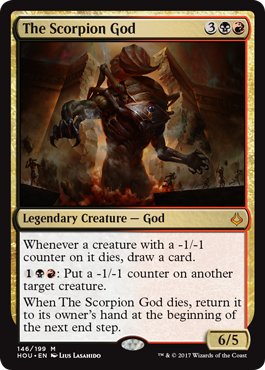
We have a rule that blocks can only have one power/toughness-altering counter. Usually that counter is a +1/+1 counter, but in Amonkhet block, we chose to make use of the -1/-1 counter. For the first set, the -1/-1 counters were more about showing the harshness of the world and creating a sense of dissonance between the happiness of the creative direction and the meanness of the gameplay.
Hour of Devastation, though, has a destruction theme. We wanted to get the sense of a disaster movie as Bolas and his minions start destroying the city of Naktamun. In Amonkhet, the -1/-1 counters are most often put on your own creatures, but Hour of Devastation starts letting you put more of them on the opponent's creatures to capture this sense of destruction.
Mummies
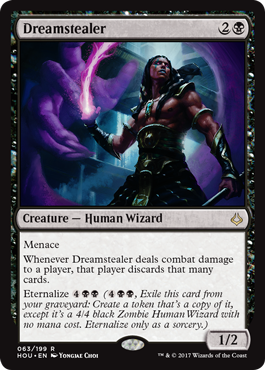
In Amonkhet, we meet two types of mummies—the white cooperative, docile Zombies that act as servants in the city, and the black wild Zombies found outside the city in the desert. These mummies teach you that everything that dies on this world returns as a Zombie and that the people have found technology to control the Zombies through cartouches.
Hour of Devastation introduces a new type of mummy: the Eternals. Like the white mummies, the Eternals are controlled using cartouches, but they are far from docile. Bolas has used the elaborate ritual of the five Trials to build himself a Zombie army. The Eternals show up in different colors (blue, black, and red) and come with two new mechanics: afflict (Whenever this creature becomes blocked, defending player loses N life) and eternalize (a tweak on embalm that I'll talk about below).
Deserts
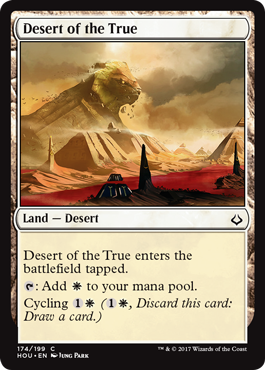
Amonkhet had a number of nonbasic lands with the Desert subtype, but nothing in the set encouraged you to want to mechanically play them together. Hour of Devastation introduces fifteen new Deserts along with various cards that mechanically care about them. This plays into the story where Bolas has brought down the Hekma, the barrier that protects the citizens of Naktamun from the dangerous elements outside the city.
In each of the cases above, Amonkhet was able to use themes that played into its Egyptian-influenced top-down design to create themes that Hour of Devastation could then take and expand upon.
#2—Twist Your Existing Themes
This idea of building upon preexisting material also extends into the mechanics themselves. Let's talk about two mechanics in particular:
Embalm
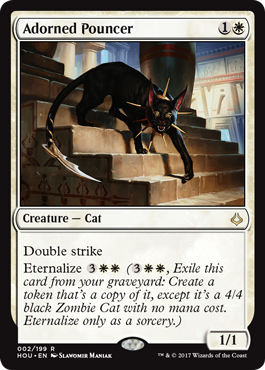
Mummies were an important part of Amonkhet, so we included a mechanic that demonstrated how creatures could die and then return to the game as mummies (okay, technically Zombies). I explained last week how embalm played into many different Egyptian themes, but it was serving a secondary purpose.
Hour of Devastation needed to focus on the Eternals. Since we already had a mechanic about becoming a mummy, we looked to see if there was a way to tweak that mechanic to both create continuity for the block while also putting a spotlight on the new set. We examined many ways to do this, but in the end, we decided we wanted to reinforce how powerful this Eternal army was. Hour of Devastation was about reaffirming Nicol Bolas as a villain, so it was important that his accomplishment here seemed worthy of his villainy.
The trick was we wanted the two mechanics to feel connected rather than eternalize feeling like a completely new mechanic, so we made the choice to just change one thing. Instead of the clone tokens being a copy of the power and toughness of the copied creature, they now instead were always a 4/4. That both captured the sense of power we wanted but also kept eternalize feeling like an extension of embalm.
Speaking of eternalize, it's time for my preview card. If you'd like to meet Champion of Wits, click below.
Click to See Champion of Wits
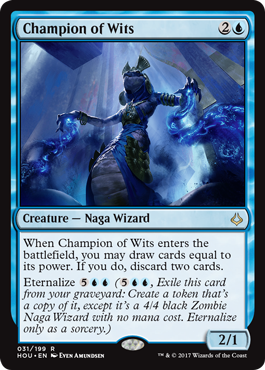
Champion of Wits is a good example of one of the biggest design challenges of making creatures with eternalize. We wanted the 4/4 body to mean something over and above simply being a bigger attacker or blocker. There were a bunch of different tricks that you'll see as we preview other eternalize cards. Champions of Wits references the power of the creature, allowing its functionality to get better when it comes back with larger stats. It goes from being a card filterer to being a card drawer.
Exert
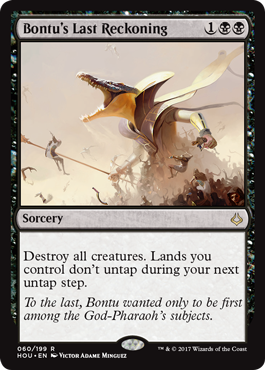
We included exert in Amonkhet because we wanted the sense that something was artificially pushing the citizens toward their self-destructive behavior. As that something was Bolas, this mechanic already was pushing in the correct direction for the second set. Mostly what we wanted to do was up the stakes a little. Bolas has arrived, which means his influence grows even stronger.
The tweak for exert was twofold. First, we expanded how exert could be used, now allowing it as a cost on things other than just attacking. For instance, it was now a cost for activating abilities on a permanent. Second, we pushed how strong the exert effect could be. Rather than just keeping the creature with exert from untapping, we now allowed exert to keep other things from untapping as well. There's a rare "Last" cycle showing the fate of the five monocolor Gods that allows you to do large effects for low amounts of mana, but at the cost of not untapping any of your lands on your next turn. (Note that this cycle doesn't actually use the word "exert.")
With both eternalize and exert, we were able to tweak an existing Amonkhet mechanic to help turn up the volume on the parts that Hour of Devastation we wanted to focus on, but as both of the mechanics got their start in Amonkhet, it helped make Hour of Devastation feel like an evolution of the first set rather than a departure.
#3—Continue Neutral Mechanical Themes
Small sets like to have new mechanics. They also like to tweak mechanics from the big set. Both of those, though, add complication. This next category is a way to connect your large and small sets without necessarily adding complexity.
While you want a lot of focus on your themes, sets do allow you a little room to breathe. Not every card has to serve the same goals. This allows small sets to often make use of mechanics from the large set without necessarily needing to tweak them. Below are two examples from Amonkhet block.
Cycling
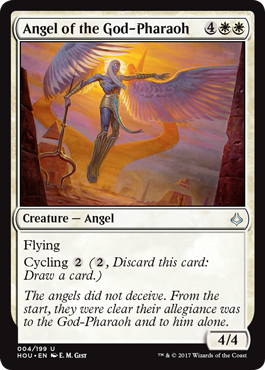
Cycling does a lot of good things for the block's gameplay. It smooths the card flow to help enable many of the other synergies to come together more often. Where cycling doesn't shine as much is in its flavor. Yeah, we used it to convey a sense of Bolas's intelligence and manipulation, but it's a light connection at best.
Its use in Hour of Devastation isn't to play up new themes as much as it's to create a sense of continuity. We added it to a cycle of Deserts and there are a few new build-arounds, but in general, the cycling in Hour of Devastation is just more of the same.
Aftermath

We talked about whether we wanted to tweak aftermath (the mechanic's name felt like a good fit for Bolas's destruction), but after looking at everything else in the set as well at the basic complexity the mechanic already had, we decided that it was better to just make more aftermath cards in the model of Amonkhet.
Both cycling and aftermath show you get to keep some things the same between the large and small sets even if the things in question are not squarely centered in the themes of the smaller set.
#4—Continue the Tropes
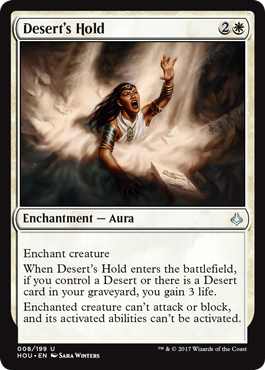
When I introduced Amonkhet, I said it was mostly top-down Egypt with a little top-down Bolas and that Hour of Devastation was going to be the reverse. That did mean, though, that we still got to spread some Egyptian influence around Hour of Devastation. There are monuments and camels and cats and scarabs. True, many of these tropes are put inside a disaster movie framework, but they still allow us to create yet another point of continuity to tie the two sets together.
#5—Use Teasers
Another way to tie the large and small sets together is to use the large set as a place to leave clues about the small set. This creates anticipation in the players who want to see the things they've heard about actually show up on cards. I have two examples from Amonkhet, one very blatant and one a bit more subtle.
God-Pharaoh's Gift
This first example was seeded by a single card in Amonkhet, Gate to the Afterlife.
The card had a bunch of different purposes. First, it majorly hinted that Nicol Bolas was going to be showing up in Hour of Devastation.
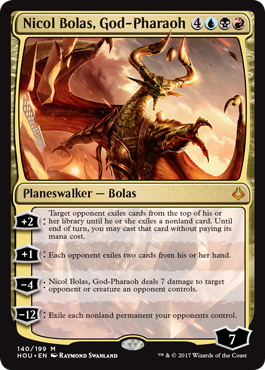
Second, it teased that the afterlife wasn't exactly what was being promised to the people of Naktamun, something that Hour of Devastation delivers with the revelation of the army of Eternals. Third, it lets the players know that a specific card, God-Pharaoh's Gift, was coming in Hour of Devastation. The card is being previewed today on another site and can be seen tomorrow in the Hour of Devastation Card Image Gallery.
The Other Three Gods
This tease was subtler. Numerous times in the story, it's made clear that there were once eight gods. As we only meet five of them in Amonkhet, it made a lot of players ask about the whereabouts of the other three gods. Obviously, Hour of Devastation pays that off in a big way, both with three new legendary creature cards and a major role in the story.
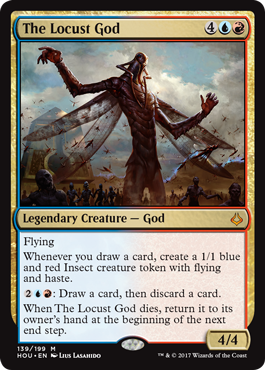
The most important things about teasers is that they create yet another connection between the large and small sets, helping the small set feel like an extension of the large set.
#6—Consider the Through-line of Your Perspective
The sixth and final point is the most complex, but also one of the most interesting things about Hour of Devastation design. Let's start with one of my design maxims: find the fun. What this means is that it's the role of a game designer to figure out what the most fun thing is about your game and make sure your game delivers on that fun thing. If the fun thing about your game is somebody is going to get a pie in their face, the game better both revolve around the threat of the pie and ultimately lead to someone getting a pie in the face.
I bring this up because one of the things we realized very early in Hour of Devastation is that the fun in this story was on Bolas's side. Do you want to be the people watching the world tumble down around them, or do you want to be the one destroying the world?
Back during Dark Ascension design, I had focused on capturing the plight of the humans who were on the brink of destruction. It wasn't until Tom LaPille, the set's lead developer, pointed out that I was focusing on the scared humans rather than the awesome monsters that I was able to see my mistake. Well, we didn't want the same thing to happen again, so we went into the design trying to allow the player to have the perspective of Nicol Bolas.
This is why we shifted embalm into eternalize and added afflict. You're the one making the Eternals. It's why we gave you access to the three new Gods, all with destructive abilities. You're the one tearing down the city. It's why we gave you a Deserts-matter theme. You're the one who brought down the Hekma (the city's protective barrier).
While this perspective was fun, it created a disconnect. Amonkhet was all about you playing as the citizens of Naktamun. It didn't feel right ignoring their plight once you moved to the small set. We solved this problem by making sure we had cards that showed the citizens being heroic. Yeah, you were with Bolas destroying the city, but there was an obstacle, and that obstacle was the people fighting you every step of the way. Games naturally want obstacles, so using that to show the resistance of the people allowed us to create a through-line while also playing up the theme of Hour of Devastation.
Our Hour Is Almost Up
Last week, I spent a lot of time talking about how Hour of Devastation was different from Amonkhet. Today, I wanted to talk about how it was also the same. As you now know, we're moving away from small sets, so I thought it was important to capture some of the challenges unique to the large/small block structure before it's a thing of the past.
As always, I'm eager to hear your feedback both on today's column and Hour of Devastation. Does it both have its own sensibility while still feeling like part of the larger block? I'm curious what you think. You can write me an email or talk to me through any of my social media accounts (Twitter, Tumblr, Google+, and Instagram).
Join me next week as I start telling some card-by-card stories about Hour of Devastation.
Until then, may you learn to cackle properly as your plans to dominate your opponent come to fruition.
#446: 20 Lessons: Bluntness
#446: 20 Lessons: Bluntness
38:57
This podcast is the fourteenth in my 20-podcast series based on a GDC speech I gave in 2016 about 20 of the lessons I've learned designing Magic for 20 years. The lesson of this podcast is "Don't be afraid to be blunt."
#447: Other Wizards Games
#447: Other Wizards Games
38:41
Magic is just one of the games Wizards of the Coast has made. Today, I walk through the many, many others.
- Episode 445 Frames (24.5 MB)
- Episode 444 Vanilla Matters (28.0 MB)
- Episode 443 "Sparks" (27.0 MB)

